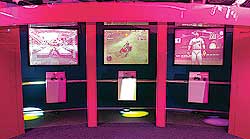|
By Alan Joch
Johnston and Lee say the amorphous nature of the project
was sometimes frustrating, but a breakthrough came when team
members discovered a shared interest in Buckminster Fuller,
particularly his spherical domes, epitomized by his Dymaxion
House (now restored at the Henry Ford Museum in Dearborn,
Michigan) and by the geodesic dome that came to symbolize
Montreal’s Expo 67. “We discovered a wonderful synthesis
of architecture, media art, and science,” Vesna says.
“The exhibition became a kind of sculpture,” she
adds, in which physical space and content were so well integrated
as to be inseparable.
While the architects responded to the symmetry and geometry
of the dymaxion structures, the scientists were drawn to the
relationships among the triangles, Lee says. “That’s
very different from the architectural standpoint, and it opened
our eyes up in terms of how this all came together,”
he says.
The 10,000-square-foot exhibition space is housed in a former
department store erected in 1929. Instead of open interior
spaces, Johnston and Lee were faced with concrete support
columns scattered throughout the floor. “We had to try
to make this forest of columns disappear,” Johnston says.
The design evolved into a 1,000-square-foot central “cell”
with a series of smaller cells connected to it. “We kept
going back to this dymaxion concept as a structural idea,”
Johnston says. “We ended up with a double-walled cylinder
of sorts that gave us a series of spaces where things could
be hidden. At the end of the day, you don’t see any computers,”
and few columns.
 |

Gaming terminals in Sony’s
Wonder Technology Lab have sophisticated lighting,
sound, and floor-vibration systems that respond
to players’ actions.
Photography:© Scott Gries |
|
 |
The central cell includes four projectors, suspended from
the ceiling, that project images of the carbon molecule C60,
a denizen of the nano world that its discoverers dubbed the
Buckyball because of its structural similarities to Fuller’s
designs. As visitors pass between the projectors and the floor,
their movements reshape the digital Buckyball images to simulate
the physical interactions that take place in the nano space.
Johnston and Lee believe the experience of designing this
show will change their work in the future. “This project
was very challenging, even frustrating at times, but it gave
us confidence that this way of working is possible,”
Lee says. “It generated a lot of ideas that we may not
have conceived otherwise.”
|


















